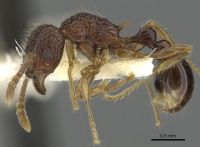Tetramorium centum
| Tetramorium centum | |
|---|---|

| |
| Scientific classification | |
| Kingdom: | Animalia |
| Phylum: | Arthropoda |
| Class: | Insecta |
| Order: | Hymenoptera |
| Family: | Formicidae |
| Subfamily: | Myrmicinae |
| Tribe: | Crematogastrini |
| Genus: | Tetramorium |
| Species: | T. centum |
| Binomial name | |
| Tetramorium centum Bolton, 1977 | |
Nothing is known about the biology of Tetramorium centum.
Identification
Distribution
Distribution based on Regional Taxon Lists
Indo-Australian Region: New Guinea (type locality).
Distribution based on AntMaps
Distribution based on AntWeb specimens
Check data from AntWeb
Countries Occupied
| Number of countries occupied by this species based on AntWiki Regional Taxon Lists. In general, fewer countries occupied indicates a narrower range, while more countries indicates a more widespread species. |

|
Estimated Abundance
| Relative abundance based on number of AntMaps records per species (this species within the purple bar). Fewer records (to the left) indicates a less abundant/encountered species while more records (to the right) indicates more abundant/encountered species. |

|
Biology
Castes
Nomenclature
The following information is derived from Barry Bolton's Online Catalogue of the Ants of the World.
- centum. Tetramorium centum Bolton, 1977: 105 (w.q.) NEW GUINEA.
Unless otherwise noted the text for the remainder of this section is reported from the publication that includes the original description.
Description
Worker
Holotype. TL 3.5, HL 0.80, HW 0.74, CI 92, SL 0.64, SI 86, PW 0.52, AL 0.96.
Mandibles striate, anterior clypeal margin entire and with a narrow but quite conspicuous apron or flange anteriorly. Frontal carinae no more strongly developed than the rugose sculpture on the head, meandering and irregular, broken in places (more sharply developed in some of the paratypes). Eyes moderate, maximum diameter c. 0.16. Propodeal spines long, narrow and acute, more or less straight. Metapleural lobes elongate-triangular and acute. Petiole with a long, downcurved peduncle, the node in profile roughly rectangular in shape, the dorsum feebly but evenly convex and slightly longer than the height of the tergal portion of the node. Postpetiole more narrowly convex, dome-shaped in profile. Dorsum of head with numerous long, irregular or meandering longitudinal rugae with scattered crossmeshes posteriorly. Spaces between the rugae showing vestigial traces of superficial sculpture but for the most part smooth and shining. Dorsal alitrunk with a loose, open rugulation, the large spaces enclosed by the meshes smooth. Dorsum of petiole with an unsculptured median longitudinal strip, the sides of the node sparsely and obliquely rugose. Postpetiole and gaster unsculptured. All dorsal surfaces of head and body with numerous fine hairs, those on the dorsal (outer) surfaces of the hind tibiae suberect to subdecumbent and much shorter than the maximum tibial width. Colour uniform dark brown, the appendages yellow-brown.
Paratypes. TL 3.3-3.5, HL 0.76-0.82, HW 0.70-0.74, CI 90-92, SL 0.60-0.64, SI 81-86, PW 0.50-0.54, AL 0.92-0.98. Maximum diameter of eye 0.14-0.16 (7 measured). Mostly as holotype but in some the frontal carinae more strongly developed, running almost to the occipital margin. Colour in some a lighter brown than seen in the holotype.
Type Material
Bolton (1977) - Holotype worker, New Guinea: Mongi Watershed, Huon Pen., Joangeng, 7-8.iv.1955, 1500 m, no. 746 (E. O. Wilson) (Museum of Comparative Zoology). Paratypes. 7 workers and 2 alate females, same data as holotype but no. 751 (MCZC; The Natural History Museum).
References
- Bolton, B. 1977. The ant tribe Tetramoriini (Hymenoptera: Formicidae). The genus Tetramorium Mayr in the Oriental and Indo-Australian regions, and in Australia. Bulletin of the British Museum (Natural History). Entomology. 36:67-151. (page 105, worker, queen described)
- Sanetra, M., Buschinger, A. 2000. Phylogenetic relationships among social parasites and their hosts in the ant tribe Tetramoriini (Hymenoptera: Formicidae). European Journal of Entomology 97: 95-117.
References based on Global Ant Biodiversity Informatics
- Bolton B. 1977. The ant tribe Tetramoriini (Hymenoptera: Formicidae). The genus Tetramorium Mayr in the Oriental and Indo-Australian regions, and in Australia. Bulletin of the British Museum (Natural History). Entomology 36:67-151.
- Bolton, B. "The ant tribe Tetramoriini (Hymenoptera: Formicinae. The genus Tetramorium Mayr in the Oriental and Indo-Australian regions and in Australia." Bulletin of the British Museum (National History): Entomology series 36, no. 2 (1977): 68-151.
- Janda M., G. D. Alpert, M. L. Borowiec, E. P. Economo, P. Klimes, E. Sarnat, and S. O. Shattuck. 2011. Cheklist of ants described and recorded from New Guinea and associated islands. Available on http://www.newguineants.org/. Accessed on 24th Feb. 2011.

